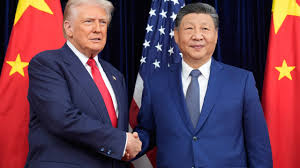SEOUL — U.S. President Donald Trump and Chinese President Xi Jinping met Thursday for the first time in six years, hailing what both sides called a “constructive and promising” dialogue even though no formal trade deal was signed.
Trump described the talks, held in South Korea, as “amazing,” while Beijing said the two leaders reached a consensus to resolve major trade issues, raising hopes for a de-escalation in tensions between the world’s two largest economies.
The meeting marks a tentative thaw in relations that have been strained since Trump reimposed sweeping tariffs on Chinese goods, triggering years of retaliatory measures from Beijing. The two nations last agreed to a temporary trade truce in May, but tensions over technology, rare earths, and tariffs remained high.
Progress on Rare Earths and Agriculture
Among the meeting’s tangible outcomes, China agreed to suspend export restrictions on rare earth minerals — critical materials used in everything from smartphones to fighter jets. The move was hailed in Washington as a major win for U.S. manufacturers.
Trump also announced that Beijing would resume large-scale purchases of U.S. soybeans and agricultural goods, a development that could provide relief to American farmers hit hard by years of Chinese retaliatory tariffs.
U.S. Treasury Secretary Scott Bessent later confirmed that China agreed to buy 12 million metric tonnes of soybeans this season, followed by at least 25 million tonnes annually for the next three years.
In exchange, Washington will ease some tariffs related to Chinese exports of chemicals used in fentanyl production, signaling a partial rollback of trade barriers that have affected supply chains across North America.
A Fragile Truce, Not a Treaty
Despite the upbeat tone, no formal agreement was reached, and most existing tariffs — averaging over 40% on Chinese imports — will remain. Still, business leaders welcomed the meeting as a stabilizing step.
Sean Stein, president of the U.S.-China Business Council, called it a “truce that gives both governments time to refocus on the long-term issues troubling the trade relationship.”
China, meanwhile, extended an invitation for Trump to visit Beijing in April, signaling a further warming of diplomatic ties.
Different Styles, Same Stakes
Observers noted the stark contrast in tone between the two leaders. Xi was measured and deliberate, describing the talks as “a good start” toward easing mutual economic concerns. Trump, more animated, claimed he had achieved “tremendous progress” in just 80 minutes of conversation.
Behind the scenes, both sides continue to grapple with deeper disputes — including over AI chip exports, TikTok’s U.S. operations, and China’s broader technology ambitions.
While the day ended without a signed deal, analysts say the meeting laid the foundation for renewed engagement. “A framework and structure has been laid,” said Henry Wang, a former adviser to China’s State Council. “It may not be an agreement yet, but it’s certainly a good start.”

